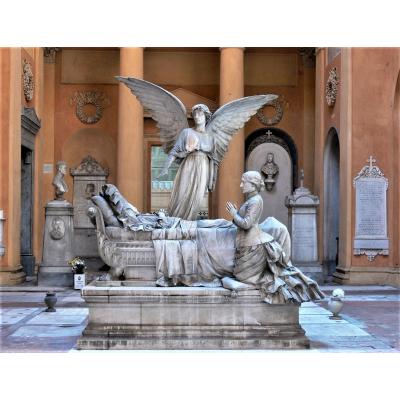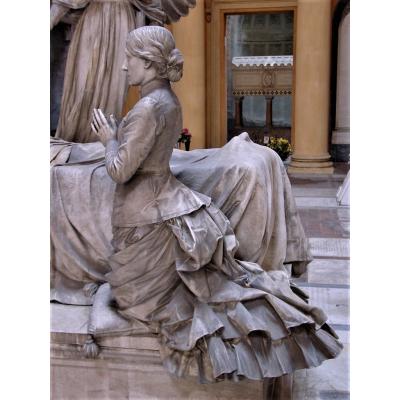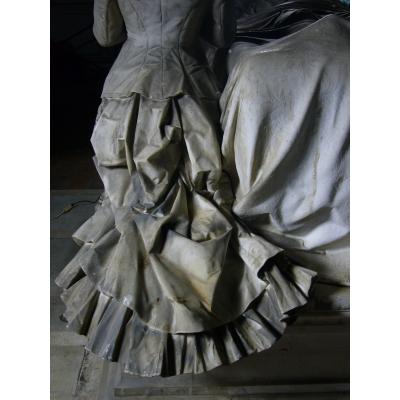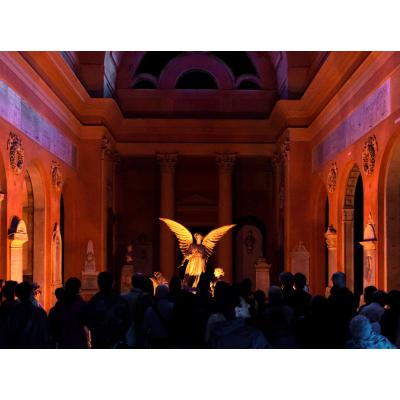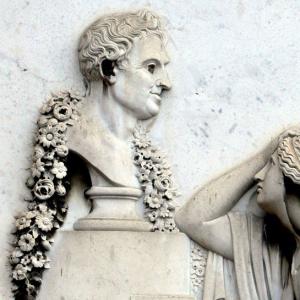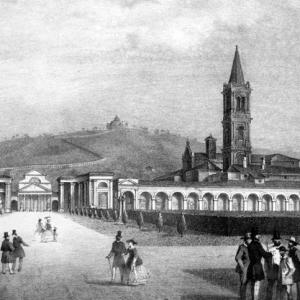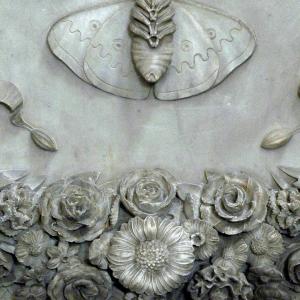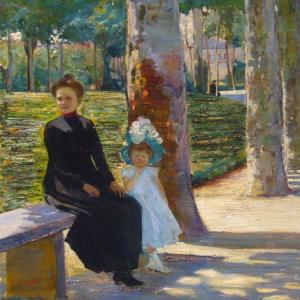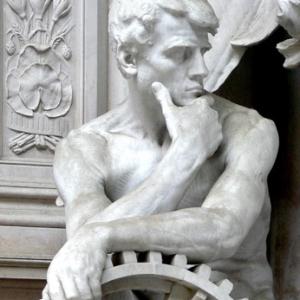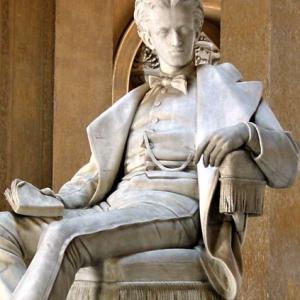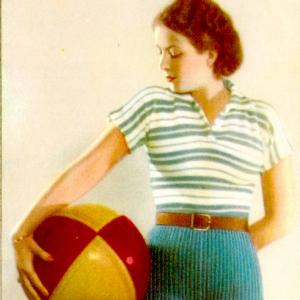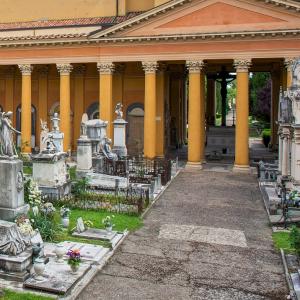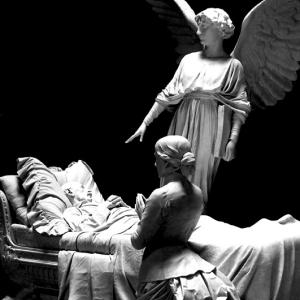Schede
The monument was erected by order of Raffaele Bisteghi, who died in May 1881 and through his will required his heirs to build the tomb for no less than 12,000 lire, a large sum at that time. In May 1882 his nephew Giovan Battista Comelli abided by his maternal uncle’s wish by acquiring a prestigious spot in the centre of the right arm of the Angel Gallery. We do not know exactly when the work was entrusted to Barberi, but the artist was certainly engaged in 1885, when the drawings that evaluate the area intended for the monument, owned by Carisbo and presented here, were dated.
We cannot rule out a commission near the time of purchase of the tomb, with work which continued for almost a decade for reasons not yet known, as the marble is signed and dated 1891. Certainly Barberi “wanted […] to be such a meditative artist that he sometimes seemed inert, and so conscientious that he could not escape the reputation of being meticulous” (E. Panzacchi, 1897). The elaboration of his works was often long, with many studies and countless drawings and models in terracotta, at times varied only in small details. As far as the conception is concerned, we need to remember the sculptor’s friendship with the painter Luigi Serra (1846-1888), as we can deduce some important elements from the latter’s correspondence. For example, we learn that Barberi stayed in Rome in his friend’s Villa Strhol-Fern studio from April until presumably December 1887 and was very busy studying this monument in those months: in Serra’s letter to his mother dated 14 May 1887 he wrote: “Give my regards […] to Dr. Veratti and tell him that Barberi has already done all the bulk clay for Bisteghi […]. And what’s more it is very good”. In the letters he wrote to his mother during those months when they lived together, Serra often seems irritated by the sculptor’s slowness and says he intends to encourage him and help him complete the work. The two therefore had the chance to discuss the monument’s compositional success, and several Serra drawings kept in the GAM collection would suggest that the idea of the realistic portrayal of the dying man, with his head sunk into the pillow in accordance with a pictorial “snapshot”, was his invention, while Barberi’s drawing owned by Carisbo, dated 25 September 1885, in which he outlines the emaciated face of the “curate” that is possibly linked to the first studies for this composition, remains significant. Certainly the verist intention is common to both artists and the culmination of a development that shifts from the late 1700s dramatic, theatrical realism of which a striking example in painting is Jacques-Louis David’s The Death of Marat, to Vincenzo Vela’s Last Days of Napoleon and the highly emotional evocation of Silvestro Lega’s The Dying Mazzini, paramount examples for this work by Barberi, who must also have been familiar with Lorenzo Bartolini’s Funeral Monument to Countess Zamojoska.
In Barberi’s work the poignant evocation of suffering and the agony of the dying man are striking, but truth is dominant even where it could deflect attention: everything – the damask bedcover, the different fabrics of the clothes, the silk pillow – is rendered in detail, as in Bartolini. The brilliant marble-working technique certainly flattered the customer and the observer, but criticism was reserved for the wife’s figure which “prevents us from admiring the monument in all its parts” and was dressed in already-dated clothes at the time of the work’s inauguration. It must be admitted that this is not the most successful character of the group: she is so staid that she seems to have a “first communion” expression which hardly reflects the drama of the scene. Here probably comes into play a compromise with the customer, who in such cases would often question the artist’s choices. Thus, careful observation of the drawing and the plaster draft photograph from the City of Bologna Historical Archives reveals that in the initial design the portrait of the lady was in line with the verist choice emphasised by analysing the monument: the veil on her head preluding mourning and the emaciated face, aged and marked by time. The lady apparently did not like this, and in an age when the scalpel could not change her everyday appearance, the chisel could at least pass down a sweetened image of her old age. The angel is remarkable, swirling and floating high to invite the dying person to his new life, and masterfully rendered: the garment falling to the ground is the sculpture’s actual support, yet the fine, rhythmic folds give us a glimpse of a heel in mid-air, defying gravity in the fiction of the scene. This figure is the only element of the composition that does not follow the rigid orthogonal pattern, the garment adhering to the body’s left profile to indicate movement that places it slightly diagonally. There is already use of a language transcending truth and approaching that linear, floral naturalism and the Liberty style we will see in monuments created by his pupil Romagnoli. While Serra inspired some of the compositional choices in Barberi’s work, here there is evidence that the sculptor was customarily aided in his designs by his friend Alfredo Tartarini (1854-1905), an artist belonging to the AEmilia Ars local guild group. The standard practice that Tartarini was called upon to handle the architectural and decorative aspects of the monuments for which Barberi was commissioned emerges from documents. This applies to the Moretti tomb (1882) and the Berlinzani tomb (1888), as well as the Agostini tomb (1887), the Cavazza sarcophagus (1893) and the base of the Malpighi Monument (1897) as evidenced by documents of the GAM Tartarini Collection. In this case, the draft of the contract Barberi sent to Tartarini for approval is conserved, defining the responsibilities the stonemasons were to have for the creation and laying of the base of the Bisteghi monument, whose “drawings and other related […] remain the responsibility of Prof. Tartarini who retains the management and supervision of all the work”. It was therefore the latter who dealt with the entire base, in addition to the style of the inscriptions, as evidenced by his note which adds to the stonemason’s work “the wording as in the drawing”.
Barbara Secci
Excerpt from: B. Buscaroli, R. Martorelli (edited by), Luce sulle tenebre - Tesori preziosi e nascosti dalla Certosa di Bologna, exhibition catalogue, Bologna, Bononia University Press, 2010.

